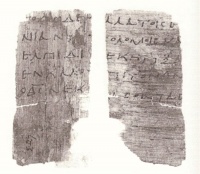Papyrus 29
From Textus Receptus
(→External links) |
|||
| Line 23: | Line 23: | ||
* [http://en.wikipedia.org/wiki/Papyrus_29 Wikipedia Article on Papyrus 29] | * [http://en.wikipedia.org/wiki/Papyrus_29 Wikipedia Article on Papyrus 29] | ||
| - | |||
* [http://163.1.169.40/cgi-bin/library?e=d-000-00---0POxy--00-0-0--0prompt-10---4----ded--0-1l--1-en-50---20-about-1708--00031-001-1-0utfZz-8-00&a=d&c=POxy&cl=CL5.1.5&d=HASH01cdb7e224458ca382037ac4 Oxyrhynchus 1597] | * [http://163.1.169.40/cgi-bin/library?e=d-000-00---0POxy--00-0-0--0prompt-10---4----ded--0-1l--1-en-50---20-about-1708--00031-001-1-0utfZz-8-00&a=d&c=POxy&cl=CL5.1.5&d=HASH01cdb7e224458ca382037ac4 Oxyrhynchus 1597] | ||
Revision as of 00:19, 2 November 2011
Papyrus 29 (in the Gregory-Aland numbering), designated by ![]() 29, is an early copy of the New Testament in Greek. It is a papyrus manuscript of the Acts of the Apostles, it contains only Acts 26:7-8 and 26:20. The manuscript paleographically has been assigned to the early 3rd century.[]
29, is an early copy of the New Testament in Greek. It is a papyrus manuscript of the Acts of the Apostles, it contains only Acts 26:7-8 and 26:20. The manuscript paleographically has been assigned to the early 3rd century.[]
Contents |
Description
The Greek text of this codex too short to put in a family. Grenfell and Hunt noticed its agreement with Codex Bezae, 1597, and some Old-Latin manuscripts.[] According to Aland it is a "free text" and it was placed by him in Category I.[] According to Bruce M. Metzger and David Alan Black[] the manuscript might be related to the Western text-type, but Philip Comfort stated "the fragment is too small to be certain of its textual character".[]
It is currently housed at the Bodleian Library, Gr. bibl. g. 4 (P) in Oxford.[][]
See also
References
Further reading
- B. P. Grenfell & A. S. Hunt, Oxyrynchus Papyri XIII, (London 1919), pp. 10-12.

